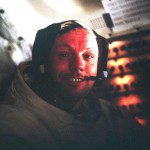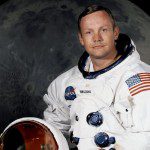Neil Armstrong: From the Heart of America to First Human Steps on the Moon
By • September 13, 2012 0 1343

The day after the first man to walk on the moon passed away at the age of 82, nothing much had changed at the Air and Space Museum on the National Mall. The Command Module Columbia, which carried astronauts Neil Armstrong, Buzz Aldrin and Michael Collins to the moon and back could easily be spotted among the flying machines, missiles, rockets and other modules that greet you as you enter the museum.
To the left and at the east end of the hall was a display which included an identical version of the Lunar Module Eagle which Armstrong calmly and expertly maneuvered to a safe landing after the original mapped landing spot had been overshot. Here, you can see an idea of the surface of the moon, two astronauts in white suits and visored, descending to the dusty lunar surface.
It was the end of summer, and sporadic storms and black clouds sped across the sky over the mall. The museum was busy—it contains, after all, everything you want to know about air and flight, wings and space and Apollo 11 and Sputnik and the space race. But there was on this quiet season-ending day in which people fussed and whispered about a hurricane heading for Tampa and the Republican National Convention, not much here to tell you that a unique man had passed from earthly life, except for the presence of Columbia and the moon landing exhibit which are here every day. No trumpets sounded, and no floral wreaths were laid.
People did hover around Columbia and peeked into the impossibly cramped quarters through the glass, and families gathered around the moon exhibit. Every now and then, groups of three or four, usually young men, or fathers and grandfathers, stood by, peering at an 11-minute movie on the flight of Apollo 11, a movie every bit as riveting as the much more expensive ones about the Transformer wars.
A docent offered up information on the moon flight. People came and went, stood and gawked, older persons explaining to younger one. “Did that thing go to Mars?” asked a five-year-old. “No, son, it went to the moon.”
Neil Armstrong went to the moon, and said words enshrined in schools, in national memory, although to his dying day, he did insist that he might have somehow misspoken or been misheard. “That’s one step for man, a giant leap for mankind” is what everyone thought they heard. Armstrong said he had intended to say “one step for a man,” but apparently he had not. The difference is, of course, how Armstrong saw himself in the scheme of things. That momentous step was the climax to an ambitious, inspired American push to space flight and to the moon, sparked by a Soviet Sputnik leapfrog ahead of the U.S.. The space race was one of the by-products of that early Russian success, which included putting men and a dog into space, but the result was entirely America at its best.
The quiet Sunday would have been appreciated by Armstrong, who was one of those men who hated the spotlight for its own sake. It is not that he was taciturn or had nothing to say: obviously he said just the right things in the right tone. He simply did not like the idea of being a hero, a hero figure and its present dilution, the celebrity. It’s fair to say that he could have entered politics and succeeded, as did fellow astronaut and Buckeye John Glenn, who did not get to the moon, but managed to become, late in life, the oldest man in space. Nor was he so quiet that he resembled President Calvin Coolidge. Armstrong had a smile that could brighten up dark spaces, as he showed from an in-flight photo and, in another, the exuberance he displayed with his family, the object of adulation and a ticker tape parade.
He was by profession an engineer who lived and loved to fly—he flew for the first time with the help of his father at the age of 16 near the farming town of Wapakoneta, Ohio, when he skipped school and went with his dad to go up in a Ford Trimotor prop lane. He had a pilot’s license at the age of 16; you could guess where his life might head.
Armstrong who flew combat jets in Korea, became the first civilian to become a part of the second group of men selected to be NASA astronauts for the U.S. space effort. He was a brilliant engineer and a cool customer at the control of space crafts. Listening to his voice on the tape of the landing—the module was running out of fuel (30 seconds left)—is as exciting as any contemporary thriller. The voice is steady, rolling off time and numbers, the presence of dust, and the simple “Houston, Tranquility base here.” “The Eagle has landed.” There was no way we could tell that his heart and pulse were running as fast as a rabbit, although his heart rate was recorded at 150.
Every bit of that flight was dangerous and its success a triumph of technology, stout hearts, talent and a nation’s willingness to put enormous resources into the effort. It happened on July, 20, 1969, a turbulent time of dissent and discontent in America with an unpopular war raging. Richard Nixon was president, as John F. Kennedy’s inspiration and dream for the moon flight became a reality.
Thereafter, Armstrong said he would not fly again. There was a biography, some rare interviews, but he entered into a successful, and for the most part, contented life, becoming a teacher and then a consultant or board member for various businesses, which had an engineering connection. As someone in some imagined future might say, “lived well and prospered.” Like all the astronauts—Sally Ride, the first woman to go into space who passed away recently comes to mind — Armstrong stayed in the mind and memory, and because his were the first, perfectly-fit human steps on the moon, the name lasted longer, even if it became hard to conjure up the image of his face.
He lived a life—early in his first marriage, he lost a two-year old daughter, and he had other children and many grandchildren and married twice.
Chris Cutrofello of Alexandria, Va., and his friend Cara Treglio of Greenbelt, Md., seemed to capture the feeling of those who remembered, even though neither was alive when Armstrong made such a history.
Treglio had placed a small, yellow flower on top of the information display block for the Columbia module. “I don’t know,” she said. “I wanted to bring a bouquet. I just thought we should come and show our respect for him today.” Cutrofello said, “I’m not sad. Usually, you know, when somebody dies, you’re sad for them, and for their families, but not in his case. I didn’t know him. I wasn’t alive then. But, hey, look at him. He made me think of what a hero should be. He was a hero for us and the rest of the world. And he had a wonderful life.”
“I mean, come on,” he continued. “The guy WALKED on the moon.”
- Neil Armstrong



